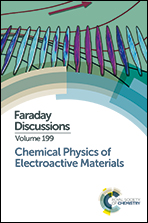Fundamental aspects of electrochemically controlled wetting of nanoscale composite materials
Abstract
Electroactive films based on conducting polymers have numerous potential applications, but practical devices frequently require a combination of properties not met by a single component. This has prompted an extension to composite materials, notably those in which particulates are immobilised within a polymer film. Irrespective of the polymer and the intended application, film wetting is important: by various means, it facilitates transport processes – of electronic charge, charge-balancing counter ions (“dopant”) and analyte/reactant molecules – and motion of polymer segments. While film solvent content and transfer have been widely studied for pristine polymer films exposed to molecular solvents, extension to non-conventional solvents (such as ionic liquids) or to composite films has been given much less attention. Here we consider such cases based on polyaniline films. We explore two factors, the nature of the electrolyte (solvent and film-permeating ions) and the effect of introducing particulate species into the film. In the first instance, we compare film behaviours when exposed to a conventional protic solvent (water) with an aprotic ionic liquid (Ethaline) and the intermediate case of a protic ionic liquid (Oxaline). Secondly, we explore the effect of inclusion of physically diverse particulates: multi-walled carbon nanotubes, graphite or molybdenum dioxide. We use electrochemistry to control and monitor the film redox state and change therein, and acoustic wave measurements to diagnose rheologically vs. gravimetrically determined response. The outcomes provide insights of relevance to future practical applications, including charge/discharge rates and cycle life for energy storage devices, “salt” transfer in water purification technologies, and the extent of film “memory” of previous environments when sequentially exposed to different media.
- This article is part of the themed collection: Chemical Physics of Electroactive Materials


 Please wait while we load your content...
Please wait while we load your content...